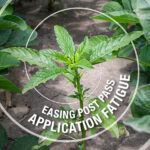Prepare for the March of Fall Armyworm
Changing weather patterns can ramp up fall armyworm populations but the right insecticides can help relieve the pressure in cotton fields.

Cotton growers meet this familiar foe on the battlefield every year, but be warned: Changing weather patterns can cause fall armyworm populations to explode early in the season, setting the stage for multiple generations to lay siege to your crop.
Extreme weather events, especially mild, wet winters followed by drought conditions create the ideal environment for these armies to grow. From there, strong winds and storms can aid their migration to other fields and regions.
In the South, growers need to be mindful of the double-whammy of wet fields. Frequent rainfall creates a favorable environment for the survival of eggs and larvae, but it also prevents control if wet fields are inaccessible.
Know Your Enemy
Fall armyworm’s identifying characteristic is a prominent inverted “Y” marking on the back of its head. Four large black dots on the last body segment of fall armyworm differentiate it from bollworms. Their color varies from light green to almost black.
Larvae go through six or seven growth stages, ultimately reaching a body length of up to 1.5 inches. The caterpillars are easy to miss at earlier stages, but they become more destructive as they grow.
Fall armyworm is one of the most devastating armyworm species to cotton because they tend to feed on fruiting structures and bolls. They can cause severe defoliation in pre-bloom cotton. According to the University of Texas A&M Extension, severe damage occurs when fall armyworm tops the plant, cutting branches and severing stalks. The greatest potential for yield loss occurs during boll filling.
Act Fast to Control the Army
In Southern states, each generation of fall armyworm may spend as little as three weeks as larvae. Larger caterpillars may be less susceptible to control measures, so being proactive is key – starting with frequent scouting and full rates of the right insecticides.
When scouting for fall armyworm, keep the following tactics in mind:
- Sample with a sweep net. Keep the opening of the net vertical and swing in 180° turns to maximize contact with vegetation. Repeat this process in several locations and fields. Fall armyworm are most active in the early morning and late afternoon.
- Know the treatment threshold. Empty the net into a sealable bag and carefully examine the contents. If you find more than 10-20 larvae per 100 plants, an insecticide application is warranted to defend your marketable yields.
If the treatment threshold is reached, it’s time to think about your next plan of attack. Powerful insecticides like Besiege® can defend your fields from fall armyworm and other insect threats. Besiege contains two active ingredients and dual modes of action to support resistance management strategies while helping turn the tide of the battle with fall armyworm.
Remember, fall armyworm migrates and reproduces rapidly. Scout for fall armyworm until defoliation to avoid surprise attacks and keep an eye on the weather all winter long to prepare for next season.
2 Min Read
- Mild winters and wet weather in the South create ideal conditions for fall armyworm populations to explode.
- Multiple generations of fall armyworm damage cotton crops every year.
- Regular scouting and applications of insecticides like Besiege® are important strategies in the battle against fall armyworm.


















